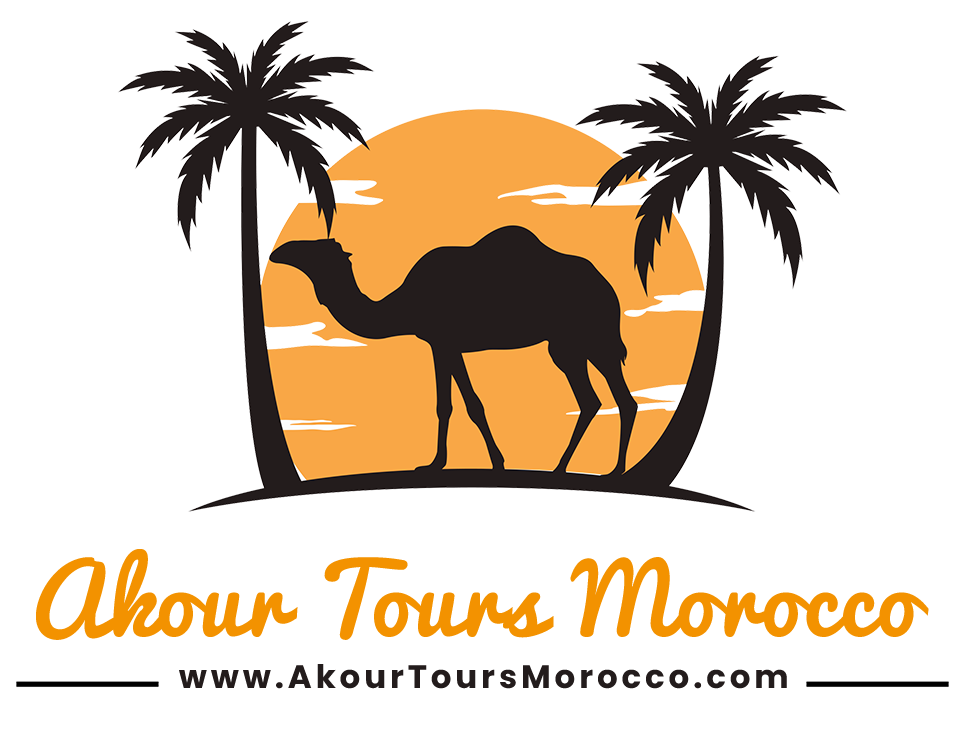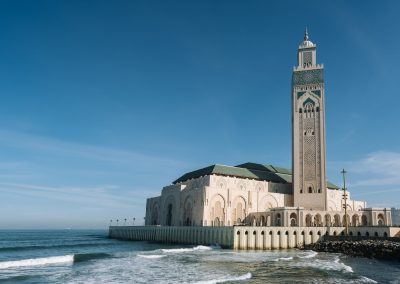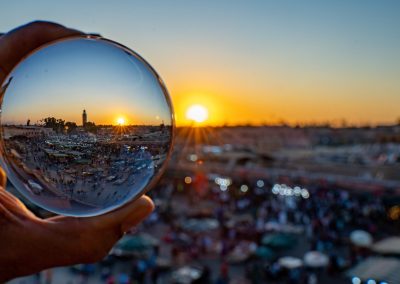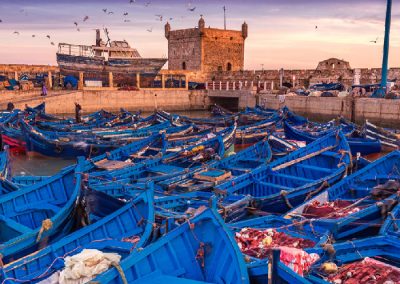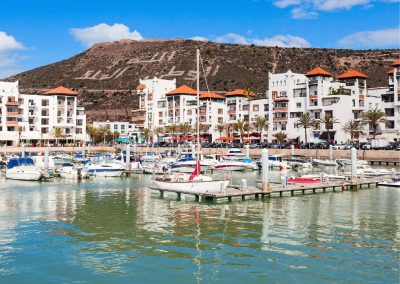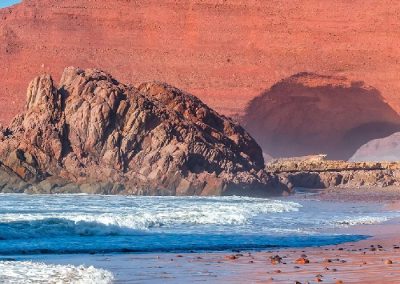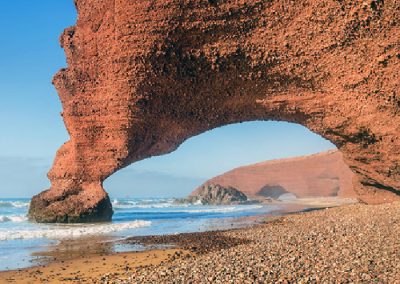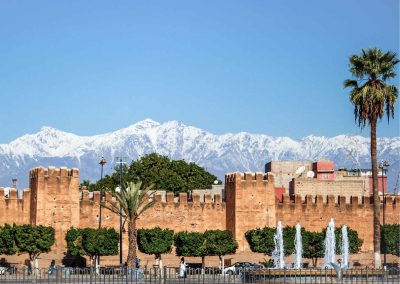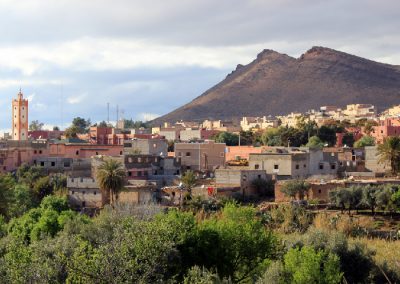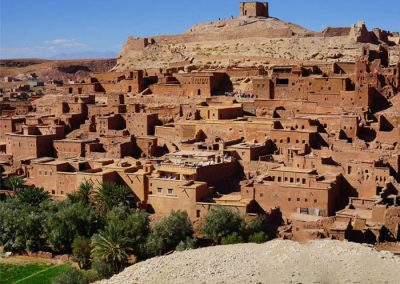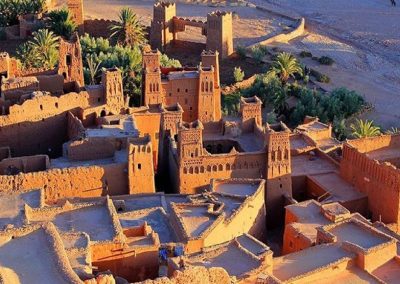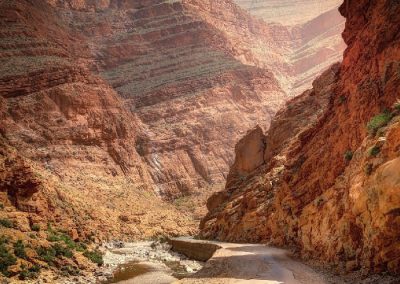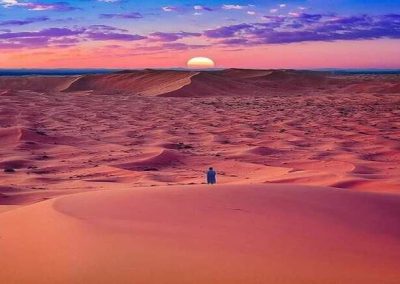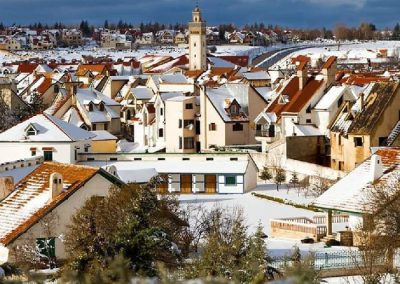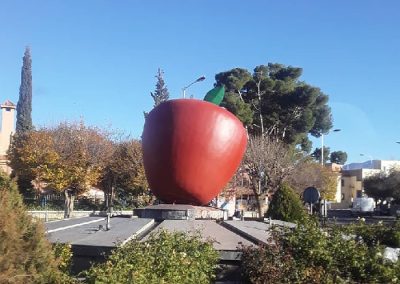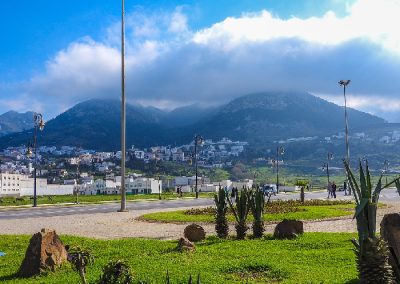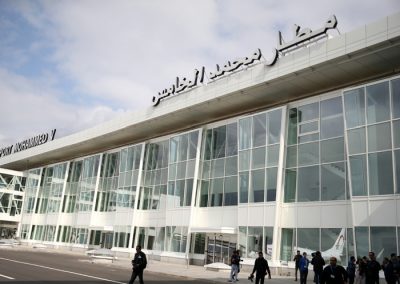the great morocco (16days / 15nights)
TOUR 16 Days / 15 nights
Day 1: Casablanca – Marrakech
As soon as your plane lands, our driver will already be waiting for you to start your trip. We will then make our way to Marrakesh, also known as Morocco’s “Red City”. Drop-off at the hotel. Free time to discover the city. Night at the hotel.
Day 2: Full day in Marrakesh
After breakfast, you will have a guided tour around Marrakesh, where you will discover many places of historical and cultural interest, including Koutoubia Mosque’s minaret, the Saadian Tombs, the astonishing Bahia Palace, and the Ben Youssef Madrasa, a Koranic school. At last, you will be able to wander around the medina’s labyrinth-like narrow streets. Here, you will have the opportunity to witness the multiple artisans working on their masterpieces, right before reaching the famous Jamma el-Fnaa Square. After eating lunch on your own, we will visit the Majorelle Garden, and make a quick visit around the Gueliz district, the new part of the city. After eating dinner on your own, we strongly recommend you to walk around the Jamma el-Fnaa Square. You will be able to enjoy its beauty at night, as well as its magicians, storytellers, tooth pullers, and food vendors. Night at the hotel.
Day 3: Marrakesh – Essaouira
After breakfast, we will set off towards the coastal village of Essaouira, formerly known as Mogador. You will be able to wander around the medina’s narrow streets and its multiple craftsmen. Essaouira, also known as the “Windy City”, draws surfers from all over the world. Essaouira has lived under many different civilizations, including the Portuguese occupation, which signs most of its architecture. However, Essaouira still is a small, but very charming, coastal village with plenty of history. Due to its size, its characteristic blue doors and its washed walls, it is also known as the “Jewel of the Atlantic”. You will be free to eat lunch wherever you want in the medina or the port, where you will be able to taste the delicious freshly caught fish and seafood. Night at the hotel.
Day 4: Essaouira – Agadir
After breakfast, we will head south to explore and discover Agadir’s beautiful beaches. We will reach a strategic location from where we will have a breathtaking panoramic view of Agadir and its bay. Free time. Drop-off at the hotel. Night at the hotel.
Day 5: Agadir – Sidi Ifni – Explore the Legzira beach
After breakfast, we will head towards Sidi Ifni, a ghost town known for its natural beauty. There are still some traces of the Spanish presence, particularly in the street names of Spanish cities and surnames, and its old Plaza España, which remain intact. Sidi Ifni is a peaceful village with kind and welcoming people, surrounded by pristine and breathtaking beaches. Afterwards, we will explore one of the most beautiful beaches in the area, the Legzira beach. You will have the rest of the day to enjoy the sun, the sea and answer the call of nature by photo shooting this beautiful landscape. We will finally head back to spend the night at Sidi Ifni. Night at the hotel.
Day 6: Sidi Ifni – Tafraout – Taroudant
After breakfast, we will head to Taroudant. Taroudant is known for its astonishing adobe ramparts, adorned with square towers. The walls, that are in an excellent state of conservation, are stunning. Large fruit gardens surround the city and the medina, the souk of which is also very lively. A large number of decorative items, jewellery, rugs, silverware and many more antiquities can be found in the souk. Night at the hotel.
Day 7: Taroudant – Taliouine – Taznakht – Ait Benhaddou – Ouarzazate
After breakfast, we will make our way towards Taliouine, located on the slopes of the Jbel Sirwa Mountain.
This town is an administrative and local trade centre, considered to be the largest saffron production centre in Morocco. It is also famous for its oregano production, its crafts made from stone, and its honey. Our next stop will be Taznakht. It is a handicraft centre that produces Berber rugs from the High Atlas Mountains, the so-called “Ouaouzguite” Berber rugs, also known as “Ouzguiti” or “Glaoui” rugs. This is the most admired and the top-selling rug produced in this handicraft centre. This rug owes its success to the artisans’ work, and more specifically, to women, wool, beautiful colours (red, black, blue, yellow and orange) and geometric patterns.
This town has many souks that sell and distribute these rugs all over the country. These souks are very important for the local economy because of the rugs’ national and international reputation. The Berber rugs from the High Atlas Mountains normally have a yellow or orange background colour. The red colour is only used for decoration. The white colour is used to isolate and emphasize the patterns.
Saffron is used to obtain the orange dye. In addition, the other dyes used in the Berber rugs are of vegetable or natural origin, which makes them last longer. We will then explore and discover Ait Benhaddou, declared a World Heritage Site in 1986 by UNESCO. Some world-famous films and TV series, such as Gladiator, Asterix and Obelix, The Mummy, The Jewel of the Nile, Lawrence of Arabia or Game of Thrones, have been shot in such a spectacular setting. We will arrive to Ouarzazate in the evening. If you want, you will be able to visit the Atlas Film Studio the following day. Night at the hotel.
Day 8: Ouarzazate –Valley of the Roses – Todgha Gorge – Merzouga Dunes
After a pick-up at your hotel, we will set off towards palm grove of Skoura to reach the Valley of the Roses. We will be able to admire more than 700 palm trees and a great numbers of kasbah in the oasis of Skoura. We will then reach the Valley of the Roses, a charming valley where the beautiful Damask rose is harvested. After several stops along the way, we will reach the Todgha Gorge. Surrounded by a valley covered with palm trees and adobe houses, climbing enthusiasts will find in these mountains some of the best climbing spots in Morocco. The Todgha and Dadès faults are the most well-known and breathtaking faults in Morocco. After wandering around the Todgha Gorge, we will resume our trip towards the desert to reach the magnificent dunes in Merzouga. Drop-off at the hotel. Free time. Night at the hotel.
Day 9: Tour in a 4WD – Rissani – Camel ride and night in a haima
After breakfast, we will hop on the 4WD to visit Khamlia, a small village founded by Malian slave descendants. We will attend a private Gnawa music concert while we sip on some welcome tea. We will then visit the kohl mines and drink some more tea with the nomads. Afterwards, we will visit Rissani, Morocco’s former capital. This traditional village was at the origin of the ruling family in Morocco, and the meeting point for trade caravans that came from as far as Timbuktu, in Mali. We will visit its bustling market and the Moulay Ali Cheriff mausoleum. We will see many hooded men and veiled women there. After lunch, we will drive back to Merzouga for a quick rest. In the afternoon, we will ride the camels, guided by an experienced camel driver from the area. We will admire the astonishing sunset on the dunes before reaching the campsite for the night. We will have a typical Moroccan dinner, which includes a tagine and delicious mint tea. We will enjoy some drum music by the bonfire and observe the magnificent sky and the stars. Night in a haima.
Day 10: Merzouga – Midelt – Azrou – Ifrane – Fez
Don’t forget to wake up at the crack of dawn to walk up the highest dune next to the campsite to enjoy the sunrise and the relaxing landscape that nature offers. After having a delicious breakfast, we will say goodbye to the desert. Our trip will continue through the magnificent Ziz Valley and the Tafilalet palm grove, famous for its dates crops. This palm grove spreads across more than 20 km, and it has more than 10 million palm trees, which makes it one of the biggest palm groves in the world. We will make our way to Midelt for lunch. We will then drive through the famous cedars forest and admire the great Cedar Gouraud, the largest ancient cedar in the region. We will be able to feed the hundreds of wild monkeys that live in the area. Afterwards, we will reach Ifrane, also known as the “Moroccan Switzerland” because of its striking resemblance with that country. One of the animals that used to live there was the Atlas lion. That’s why it has become the city’s landmark and a stone statue has been dedicated to it. We will have time to take some pictures. We will arrive to Fez in the afternoon. Drop-off at the hotel. Free time. Night at the hotel.
Day 11: Full day to explore and discover Fez
After a delicious and fulfilling breakfast at the hotel, we will start our guided tour in the new part of the city, where we will discover the Royal Palace and the Jewish quarter (Mellah). We will also go to a viewpoint from where we will have an overview of the medina from the Southern Tower and the mosques. We will then wander around the medina, declared World Heritage Site by UNESCO. We will visit the Al-Karaouine University; the Nejjarine Fountain; and the Cherratine and Al-Attarine Madrasas, both decorated in an Arabic style and devoted to the study of religion. We will soon notice that it’s a medieval city, where time has stopped on the Dar al-Magana’s clock 1200 years after its completion. The tour includes a visit to a ceramic workshop. Its labyrinth-like narrow streets are organized by unions: potters, dyers, tanners… The bustle of these people will make us travel back in time. Free time. Night at the hotel.
Day 12: Fez – Volubilis – Moulay Idriss – Meknes
After breakfast, we will visit the Roman ruins of Volubilis. This Roman archaeological site, that spreads over 20 ha, contains a myriad of archaeological remains and monuments. This is quite astonishing if we consider that just half of it has been excavated for now. The most important remains are the Forum, a basilica from the II century and the Capitoline Temple, located on the highest point of the city, as Roman tradition requires; and the Arch of Caracalla, located on the Decumanus and built in 217 to thank the Emperor for expanding the Roman citizenship to every single inhabitant of the Empire. Some thermal baths, oil presses, shops, as well as some houses, which follow the typical Roman design, have also been unearthed. Decorative mosaics have also been discovered in the residencies of the richest inhabitants. We will then have a panoramic view of the holy city of Moulay Idriss. We will arrive to Meknes, the smallest of all the Imperial cities, in the afternoon. We will visit the fortified medina, the astonishing Bab Masour gate, the el-Hedim Square and the Sultan Moulay Ismail’s stables and barns in the city that carries the name of this Great Sultan of the Alaouite Dynasty. Free time. Night at the hotel.
Day 13: Meknes – Chefchaouen
After breakfast, we will head towards Chefchaouen, also known as the “Blue City”. Chefchaouen is located in the only intercontinental natural park, declared a Natural Biosphere Reserve. The oldest part of town stretches towards the top of the mountain and, at its highest point, we can find the Ras al-Ma springs. A citadel and a mosque with an octagonal base tower can be found at the Uta al-Hammam Square, the heart of the town. The Grand Mosque of Chefchaouen is another one of the town’s landmarks. The new part of town has been erected underneath the old town. Inhabited by wise, kind and respectful people, Chefchaouen offers beautiful urban landscapes, fine local handicrafts, and a state of peace and calm that is quite hard to find in our modern society. Night at the hotel.
Day 14: Chefchaouen – Tetouan – Asilah
After breakfast, we will head towards Tetouan, also known as Morocco’s White Dove. You will have free time to explore the city and then, we will head towards Tangier. We will make a quick stop where we will be able to see the beach through the main avenues of the new city. We will also stop and explore the Caves of Hercules and Cape Spartel, the northern end of the African continent. We will resume our trip to the small seaside town of Asilah. The walls surrounding the town were built in the XV century by Afonso V of Portugal. We can still see several old cannons near the seaside area. Bab el Bhar, also known as “the sea gate”, as well as the squared Portuguese tower that overlooks the entire town, are located in the Sidi Ali Ben Hamdouche Square, the interior of which holds temporary exhibitions. Near the seaside, we can find the Raissuni Palace, a Hispano-Moresque mansion, now a cultural palace and the seat of the cultural museum. The medina consists of neat white houses with colourful mural paintings. The street lighting is original, and the paved streets are masterpieces made by local artists. A Muslim graveyard with ceramic multicoloured tombstones stands out near the sea. There is also the Sidi Ahmed Ou Moussa mausoleum, Saadian who reconquered the town after the “Battle of Three Kings”. Free time. Night at the hotel.
Day 15: Asilah – Rabat
After breakfast, we will head to Rabat, Morocco’s capital city. Once we reach Morocco’s capital city, we will visit the Kasbah of the Oudayas, an ancient military fortress that was declared a World Heritage Site in 2012 by UNESCO. In this citadel, we can find the famous monumental door Bab el-Kébir, as well as one of the first palaces ever built by the Alaouite dynasty, which still reigns over Morocco. We will then visit the Hassan Tower. On the esplanade, we will see a minaret and dozens of columns, which are the remains of an unfinished mosque. The Mausoleum of Mohammed V, the first king of independent Morocco, was also built on the unfinished mosque’s esplanade. He is buried in the mausoleum, as well as his son and successor Hassan II, father of the current king. Free time. Night at the hotel.
Day 16: Rabat – Casablanca airport
After breakfast, we will make our way to Casablanca for a drop-off at the airport. Airport drop-off. End of our services.
The price includes
- Airport or hotel transfers in Casablanca.
- Private transport with A/C
- English-speaking driver/guide at your service during the whole trip
- Fuel
- Accommodation type: bed & breakfast, except in Ouarzazate and Merzouga (breakfast & dinner)
- Official guide in Fez and Marrakesh
- Camel ride in the desert
- Night in the desert in a haima with breakfast & dinner
Not included
- Flights
- Meals
- Dinners, except those in Ouarzazate and Merzouga
- Drinks
- Tips
Travel conditions
- Start of the trip: Casablanca
- End of the trip: Casablanca
- Accommodation in charming hotels with private room and bathroom
